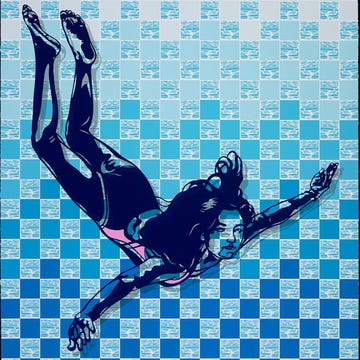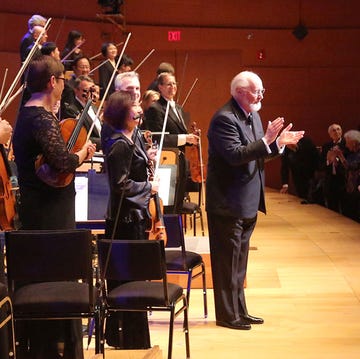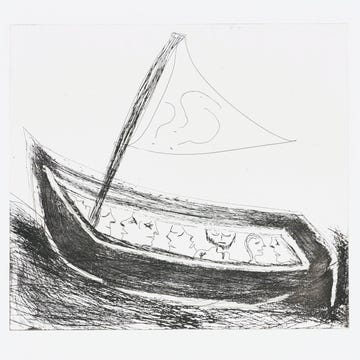Back in the 1980s when André Heller conceived of Luna Luna, an ambitious art show crossed with an interactive amusement park, he could not have imagined how much it would be on something called the internet, particularly a part of it called Instagram, in 2024.
This essay was adapted from the Alta Weekly Newsletter, delivered every Thursday. To keep reading, become an Alta Journal member for as little as $3 a month.
SIGN UP
Heller, who has a widely varying résumé but is known as a musician and multimedia artist, had an idea to get a group of artists together to create a park where visitors could climb all over the art, touch it, sit on it, walk through it, and swing around it. Heller commissioned pieces by Roy Lichtenstein, Keith Haring, Jean-Michel Basquiat, and others, who created hand-painted works on carousels, Ferris wheels, mazes, and fun house mirrors.
The festival debuted in 1987 in Hamburg, Germany, to massive success. Children ran through the grass from rides to games; adults laughed at the raunchy performance art. Summer in Hamburg that year was unusually rainy, and the grass under the amusement park dissolved into mud puddles, adding an element of chaos to the events. Luna Luna ran for three months before the pieces were carefully packaged in shipping containers, each ride meticulously taken apart and shipped to America.
And there those containers sat in the Texas desert for four decades.
In 2022, when Joel Searles opened the shipping containers, he went in relatively blind.
DreamCrew Entertainment (known for its connections to the rapper Drake), which planned to remount the show, had hired Searles to lead the restoration of Luna Luna. No one knew what kind of shape the rides were in, but they turned out to be in near-perfect condition. There was even some merchandise, promotional materials, and paint cans for touch-ups.
“It was a little bit like, Wow, I’m not sure where this was going to lead,” Searles tells me. “But I knew nothing else like it existed, so I was like, This is worth a shot. Wherever this ends up, it’s probably going to be worth the ride.”
The new Luna Luna: Forgotten Fantasy, running until May 12 in Los Angeles, lives inside a dark warehouse; its restored pieces are for viewing, not riding. Still, it is vibrant to experience, bursting with color and comedy. And it’s once again a hit, this time on social media.
In one corner of the space, a carousel covered with Haring paintings turns in slow motion. On the opposite side of the warehouse, a massive white Ferris wheel decked out in illustrations by Basquiat—including one of a baboon’s ass—spins. It is a ghostly experience to visit, imagining the visitors of its past life, their arms jutting out of the Ferris wheel cars that still turn, now carrying no one. A thorough timeline on one wall includes the prominent art, film, and music of the past few decades, as well as the rise of AIDS (which claimed Haring and millions of others), the deaths of artists, and the impact of the political climate both in the United States and in Germany, which saw the fall of the Berlin Wall two years after the Hamburg show.
Searles has a background in massive, social media–friendly artworks: for 18 years, he was the studio manager for Chris Burden, whose Urban Light, a collection of street lamps outside the Los Angeles County Museum of Art, may be the most frequently posted piece of artwork in California. Searles was the ideal studio director for a work that would be massive and massively postable. Luna Luna: Forgotten Fantasy has more than 100,000 followers on Instagram. André 3000 performed there in a series of intimate concerts. Selena Gomez and Benny Blanco visited for date night.
Renée Reizman, an art critic who teaches graphic design and visual communication at Pepperdine University and the University of Southern California, explains that she’s noticed a rise in what she calls “selfie museums,” or art experiences that are built around photo opportunities or sensory immersion. As part of a final project at USC, her students pitch an immersive experience like those that have become popular based on the art of artists like Van Gogh or Frida Kahlo.
“We’re kinda ruining people’s expectations of what art should be like; it should be fine that you go to a cool warehouse and see all these amusement park rides, and that they just exist should be fascinating enough,” Reizman says. “But now we’re spoiling people. And now they’re like, No, the carousel is not enough. I have to get on the carousel.”
Monika GilSing, one of the original Luna Luna artists and the creator of the Wind Images flags that hung high above the exhibit in Hamburg, has experienced the revitalization of Luna Luna primarily through social media. She has not yet had the opportunity to visit it, though she hopes to if the show comes to New York in the future. Her work in particular translates differently than it did in the original show, she says. GilSing explains that her banners were the first indicator to visitors from a distance that they were approaching the amusement park. The banners are, by design, meant to wave in the wind. Now they hang still in a darkened warehouse.
In a call from her studio in Germany, GilSing tells me through a translator about how her strongest memories of Luna Luna are of the rain and of working in a community of young and passionate artists: “That was just extremely valuable for [me], to this day. It was very special to not only get to know these artists but also work with them at the same time.”
“It’s changed my idea of what can happen when you get lots of artists together,” Searles adds about working on the show. “There’s not many places you can see works of this size, this many, in one room, with different artists.”
In restoring the work, Searles and his team paid careful attention to preserving the integrity of the decades-old works, even beneath their facades. The team used the same hardware when possible and did not repaint everything. The Luna Luna of 1987 is inseparable from its current version.
“Not everything was perfectly protected or packed well. Some things had some damage. The conservancy philosophy was to not fix all those things,” Searles tells me. In a David Hockney canvas, rips are clearly visible. In the immersive Salvador Dalí mirror room, some panels have cracked and broken. These show the passage of time on the show, what has been lost as well as what has been revealed. “Leave the life it already had in it—let it show the life it already has,” Searles explains.
That life continues in the warehouse—and on our phones.•
Jessica Blough is a freelance writer. A former associate editor at Alta Journal, Blough is a graduate of Tufts University where she was editor in chief of the Tufts Daily.












